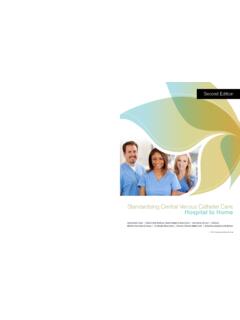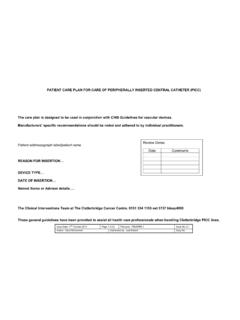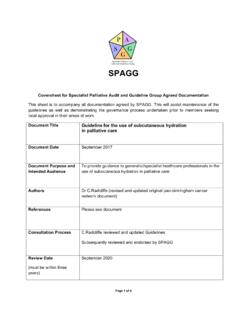Transcription of V.A.C. Therapy Clinical Guidelines
1 Therapy Clinical GuidelinesRA Reference Source for CliniciansJanuary 2005 IndexPatient Selection Criteria ..4 Indications ..4 Contraindications ..4 Precautions ..4 Care and Safety Tips ..4 Optimizing Therapy ..5 Wound Healing Progression with Effective Therapy .. Therapy Unit and Dressing Application Recommended Guidelines ..7 Choosing the Foam ..7 Recommended Guidelines for Foam Use ..7 Applying the dressings ..8 Applying the Therapy Unit ..9 Dressing Removal ..10 Canister and Y-Connector Change ..10 Follow-up on Dressing Integrity ..11 Disconnecting from Unit.
2 11 General Dressing Tips ..12 Maintaining a Seal ..12 Circumferential Drape Application ..12 Treating Multiple Wounds ..12 Y Connecting ..12 Bridging ..13 Fecal Incontinence ..13 Tunneling ..13 Wound Undermining ..14 Dressing Small Wounds ..14 Optimizing Wound Approximation ..15 Wound Observation Between Dressing Changes ..16 Adjunct Dressing Recommendations .. Instill Therapy Unit Recommended Guidelines .. Instill Patient Selection Criteria ..17 Indications ..17 Contraindications ..17 Precautions ..17 Care and Safety Tips ..17 Optimizing Therapy .. Instill General Therapy Unit and Dressing Instructions.
3 Instill Pad Aplication ..18 Applying the Instill Therapy Unit .. Instill Therapy Settings Adjustment ..19 Recommended Guidelines for Treating Different Wound Types ..20 Acute/Traumatic Wounds/Partial Thickness Burns ..20 Surgical Wound Dehiscences ..21 Meshed Grafts and Bioengineered Tissues ..22 Pressure Ulcers ..23 Chronic Ulcers ..24 Flaps ..25 Venous Grafts ..25 Recommended Guidelines for Therapy with Enteric Fistula ..26 Acute and Chronic Candidate Selection ..26 Application Directions: Acute Enteric Fistula (Complex) ..26 Application Directions: Acute Enteric Fistula (Simple).
4 27 Application Directions: Chronic Enteric Fistula ..28 Pouching / Diverting Drainage of a Chronic Fistula ..29 Troubleshooting Tips ..29 Additional Recommended Guidelines for Treating Various Wounds with Therapy ..30 Infected Wounds ..30 Wound Odors ..30 Adjusting System Pressure Settings ..30 Continuous vs. Intermittent Therapy ..31 Intensity Feature ..31 Additional Therapy Recommended Guidelines Chart .. Therapy and Hyperbaric Oxygen Therapy ..32 When to Discontinue Therapy ..32 Minimal Change in Wound Dimensions ..32 Deterioration of Wound ..33 Changes in the Wound.
5 33 Ordering The System ..34 Physician Order ..34 Transitioning Patients Between Care Settings ..34 KCI Contact Information ..34 These Therapy Clinical Guidelines are for use with the Classic, ATS Therapy systems. Not all systems have the same features nor require the sameguidelines. Please refer to the specific Quick Reference Guide, User Manual, On-Screen UserGuide and Disposable Instructions for Use (as appropriate) for specific product :Federal law restricts this device to sale or rental by or on the order of a is subject to change at any time without to Users.
6 As with any prescription medical device, failure to followproduct instructions or adjusting settings and performing Therapy applicationswithout the express direction and/or supervision of your trained clinicalcaregiver may lead to improper product performance and the potential forserious or fatal :THESE Guidelines ARE NOT INTENDED AS A GUARANTEE AS TO RESULTS,OUTCOME OR PERFORMANCE OF THE SYSTEM . THEY ARE RECOMMENDATIONS TOASSIST THE TREATING PHYSICIAN IN ESTABLISHING PATIENT-SPECIFIC TREATMENT WITH ANY APPLICATION, PLEASE CONSULT THE PATIENT S TREATING PHYSICIAN AS TOINDIVIDUAL CONDITIONS AND TREATMENT AND FOLLOW ALL APPLICABLE MANUALS ANDREFERENCE GUIDES AS TO PRODUCT USE AND OPERATION.
7 ALWAYS CONSULT THEINDICATIONS, CONTRAINDICATIONS, PRECAUTIONS AND CARE AND SAFETY TIPSSECTION OF THIS BOOKLET AND ANY OTHER PRODUCT LABELING AND INSTRUCTIONSBEFORE PLACING A PRODUCT ON A PATIENT. CONTACT YOUR LOCAL KCI REPRESENTATIVE WITH PRODUCT OPERATION USE QUESTIONS. KCI Contact Information:If you have questions, or for additional information, please contact your local KCI representative or contact KCI directly at 1-800-275-4524. Visit our website at For a medical emergency, contact your local emergency number ( 911). System - PN Disposables Non-ambulatory Moderately to heavy exudating wounds (>15 cc s/day) Multiple ATS System - PN Disposables Ambulatory or Non-ambulatory Moderately to heavy exudating wounds (>15 cc s/day) Multiple Freedom System - PN Disposables Ambulatory Moderately to heavy exudating wounds (>15 cc s/day) Multiple Instill System - PN 320100 Use only with System disposables Benefit of controlled topical solution treatment in conjunction with Therapy Moderately to heavy exudating wounds (>15 cc s/day)
8 Multiple wounds Less mobile Therapy Patient Selection CriteriaIndications:The family of devices* with woundsite feedback control are negative pressure devicesused to help promote wound healing, through means including removal of infectious materialor other fluids, under the influence of continuous and/or intermittent negative pressures,particularly for patients with chronic, acute, traumatic, subacute and dehisced wounds, partial-thickness burns, ulcers (such as diabetic or pressure), flaps and grafts. Feedback control is achieved by measuring the level of negative pressure at the wound of wounds for which Therapy currently has been indicated include: chronic partial-thickness burns pressure ulcers acute dehisced wounds flaps traumatic diabetic ulcers grafts*Certain unique indications, contraindications, precautions and safety tips may apply for distinctive products within the family of devices, such as for the Instill Systemand for systems that do not utilize woundsite feedback control.
9 Please refer tothe product labeling for each specific product. Contraindications:Contraindicated for patients with: malignancy in the wound non-enteric and unexplored fistula untreated osteomyelitis necrotic tissue with eschar present Do not place dressing over exposed blood vessels or :Precautions should be taken for patients with: active bleeding difficult wound hemostasis anticoagulants when placing the dressing in close proximity to blood vessels or organs, take care to ensure that all vessels are adequately protected with overlying fascia, tissue or other protective barriers greater care should be taken with respect to weakened, irradiated or sutured blood vessels or organs bone fragments or sharp edges could puncture protective barriers, vessels or organs wounds with enteric fistula require special precautions to optimize Therapy .
10 Refer to pages 27 - 28 of this guide for recommended Universal Precautions. Care and Safety TipsSafety Tips: Keep Therapy on:Never leave subatmospheric pressure off for more than 2 hours per 24 hour period. Remove dressing if subatmospheric pressure is terminated or is off for more than 2 hours in a 24 hour period. Dressing changes:Perform aggressive wound cleaning per physician order prior to dressing application. Routine dressing changes should occur every 48 hours. Dressing changes for infected wounds should be accomplished every 12 - 24 hours. Always replace with sterile disposables from unopened packages.




